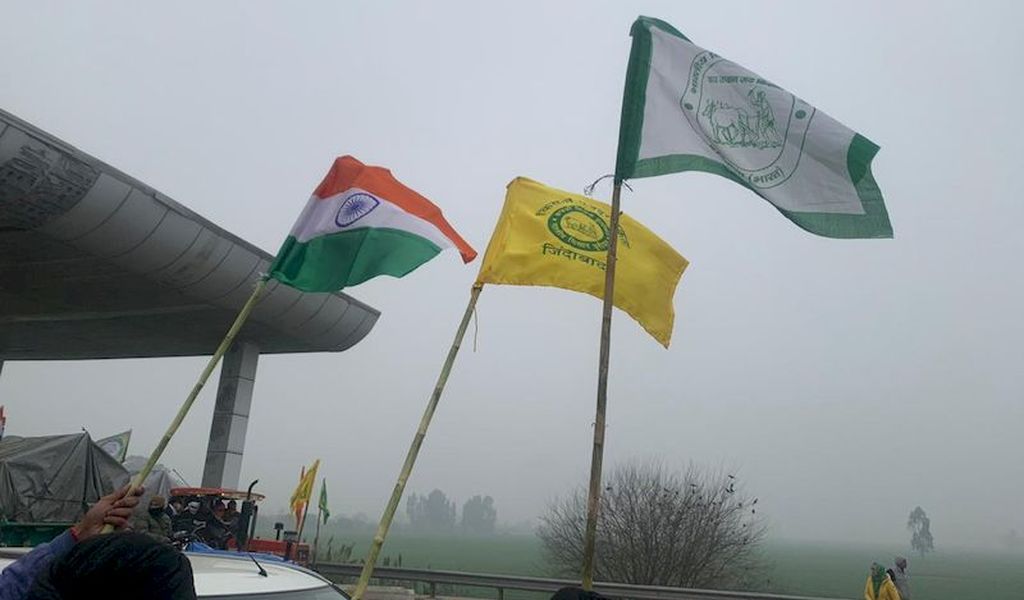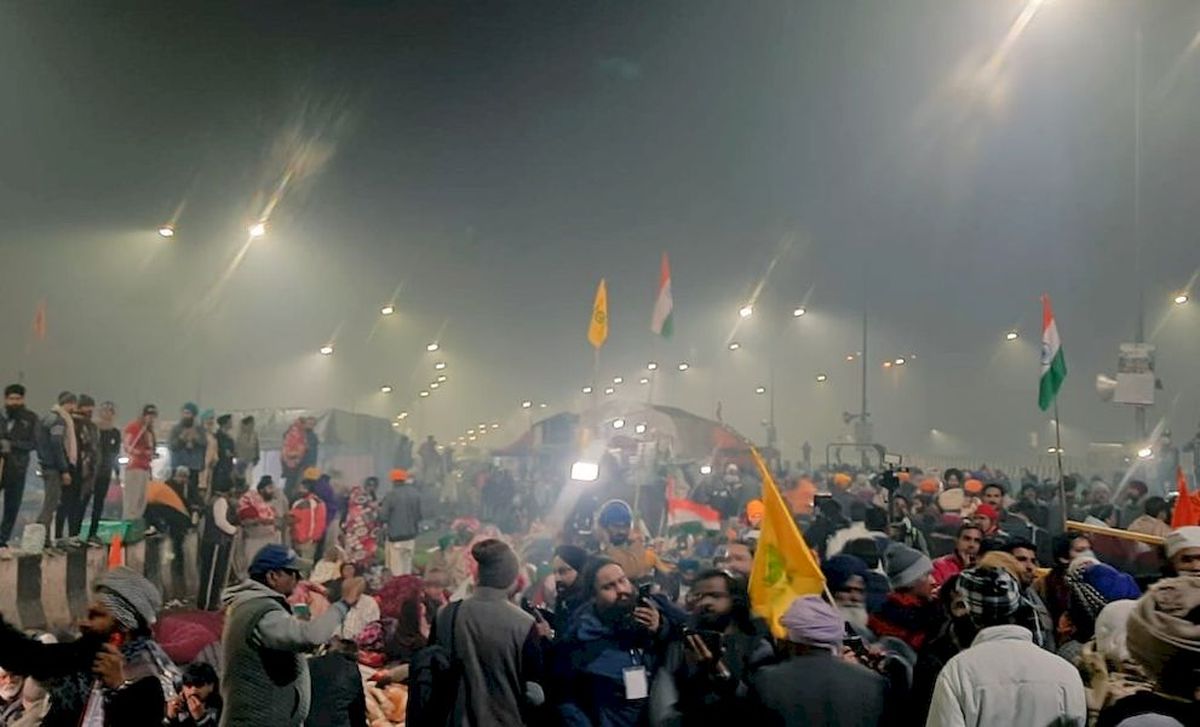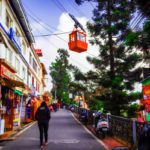In full view of police who kept watching, an estimated group of 200 people got past three layers of security barricades and damaged tents and shelters, and clashed with farmers who are protesting against bills passed by the central government.
It was the first time the violence erupted at the site of the protest since the first sit-in protest which started in Singhu on November 26.
The farmers alleged that they were attacked at the behest of the BJP to disrupt the protest against the Centre’s new farm laws.
One of those in the group that reached the site said he was the husband of a BJP councilor from a village nearby.
With both sides throwing stones at each other, Delhi Police later said that 44 people, including a 22-year-old man who allegedly attacked a sub-inspector with a sword, were arrested. It has been reported that all those arrested were farm protesters and not the hooligans who attacked the protestors.
Whether the attack was on the behest of a political party or not, one thing was very clear, there was a lot of anger for the farm protestors.
The crowd kept shouting that they would not tolerate any insult to the ‘Tricolor’ in a reference to the violence on Republic Day.
For many in the crowd, all protesting farmers have insulted the tricolor and brought a bad name to their beloved country. Perhaps their passions were also genuine and they really believed that perhaps anti-national elements, more specifically Khalistani elements have sabotaged the protest.
To be fair to the police, once the scuffle broke out after the barricade breach, the police resorted to lathi-charge and used tear gas shells to bring the situation under control. They somehow always seem to bring the situation under control after the damage has been done (read Repulic Day violence).
When attack on the capitol building happened in the US, the Capitol Police chief apologized and offered his resignation for failing to prepare for what became a violent insurrection despite having warnings that white supremacists and far-right groups would target Congress.
Sounds similar? Yes and no, while the circumstances are somewhat similar — failing to prepare for what became a violent insurrection despite the warning — the accountability is not.
There is no urgency to address the lack of security that allowed fringe elements inside the protests to march to the heart of Delhi and hoist a flag there.
Most people seemed angry about what they believed was an insult to their homeland and beloved country. As strange as it may sound, only a few unheard voices quietly said, ‘What about the failure of the administration”?
This wasn’t the first time a protest was happening against a bill passed by the central BJP government. This wasn’t the first protest in Delhi in the recent year either.
CAA Protests
The Citizenship Amendment Act protests, also known as CAA Protest or CAB Protest, occurred after the Citizenship Amendment Act was enacted by the Government of India on 12 December 2019.
The city of Delhi saw a new kind of protest led by Muslim women against the newly enacted legislation that revised the provisions under which Indian citizenship is granted.
Indian Muslims were afraid that the new law would have adverse implications for their status in the Indian union. One of the most visible signs of the movement was a loud statement of the Muslim claim to Indianness, their nationalism, and root in the land of the country.
Muslim children painted their cheeks with images of the Indian flag and every leader who spoke from the stage repeated their unwavering patriotism. Behind this display, there was a deep concern, their movement may be typecasted into an anti-national movement.
On 15th December 2019, Delhi Police forcefully entered the campus of Jamia Milia Islamia University and detained students. According to video footage, the police used batons and tear gas on the students.
More than two hundred students were injured and around a hundred were detained. The police action was widely criticized and resulted in protests across the country and abroad. There were also allegations that the police attacked students who were not part of the protests.
The reaction from the general population however was mixed, many believed that police had done the right thing. Their belief again was that the protestors were disrespecting the country and as many social media handles propagated — they are ‘anti-national’.
The result– the protests did not seem to make any difference to the ruling establishment and a section of the national media who continued to project the protestors as “illegitimate” Indians, often using popular stereotypes, to make them appear synonymous with Pakistan and Pakistanis.
How protestors become anti-national?

The term “anti-national”, used typically to suggest seditiousness in the object of the slur, is increasingly used by political parties against each other, and against individuals whose positions they are at odds with.
Those indulging in arson ‘can be identified by their clothes
Narendra Modi on anti-CAA protest
How do you identify people with their cloth who indulge in arson? Perhaps a Muslim attire will do, or else PM Modi has some explaining to do.
At the forefront of such a dangerous trend is the current ruling party BJP. During CAA protests, PM Modi followed his colleagues in dubbing the protest anti-national and an anarchist movement, inspired by the opposition.
Incidentally, this is exactly how Indira Gandhi had described the JP movement in 1974, just before declaring the Emergency. There are clear political benefits of this description, you can subdue the movement and then make political gains out of it.
But this is no ordinary political play, it has wide-ranging implications. If what happened at Singhu during the farmer’s protest is any sign, such moves can potentially turn citizens of this country against each other.
A perfect recipe for disaster and violence.
Why are people falling for such narratives?

In the current political ecosystem, the Punjabi farmers are facing the same adversary that the CAA protestors faced.
A hostile national media, slowly but surely trying to brand them as Khalistani separatists and anti-nationals. Overworked IT cells of political parties trending hashtags without ever bothering about the larger implications of their keyboard skills.
On November 30, BJP national general secretary and party’s in-charge for Punjab, Dushyant Kumar Gautam, had said in Dehradun, “Slogans of ‘Khalistan Zindabad’, ‘Pakistan Zindabad’ were being raised there.
“Slogans were being raised in favor of anti-national forces. You should think about who is behind these protests.” alleged Dushyant Kumar.
Senior leaders of BJP started openly saying that there is a hand of foreign powers and Tukde-Tukde-Gang.
Those who have invoked the phrase in the context of the farmers’ protest include former Bihar deputy chief minister Sushil Kumar Modi and former Delhi BJP chief Manoj Tiwari.
‘Tukde-tukde gang’ is a moniker that emerged after the 2016 JNU sedition controversy, with sections of the Right-wing using the phrase to describe students they accuse of raising anti-India slogans at a demonstration to mark Parliament attack convict Afzal Guru’s death anniversary.
Initially, many speculated that such a narrative will not gain traction and fail to hamper the farmer’s protest. There were very strong reasons for that too. Foremost, in India very idea of nationalism and its foundational idioms actually overlap with agriculture.
Soon after Lal Bahdur Shastri took over as the PM of India after Nehru’s death, India was attacked by Pakistan. India was facing enemy at the borders and also a severe scarcity of food grains inside the country.
Shastri gave the slogan Jai Jawan Jai Kisan to enthuse the soldiers to defend India and simultaneously cheering farmers to do their best to increase the production of food grains to reduce dependence on imports. It became a very popular slogan and has since then become synonymous with patriotism.
Everyone in India remembers the iconic posters of the movie Mother India (1957), with Nargis Dutt carrying a plow and sickle on her shoulder.
Even in modern times and historically, nationalism across the world has privileged its farming classes and it is hard to mobilize nationalist sentiment without referring to the land and its agriculture.
Another important aspect of the association of agriculture with nationalism is that of its being the recruitment base for the armed forces.
A substantial proportion of those who join the military is from farming families almost everywhere in the world.
This is equally true about India as well. In fact, a good number of soldiers in the Indian military come from the farming households of the states of Punjab, Haryana, and Uttar Pradesh.
Even then the entire narrative change when violence broke out on the day of the Republic Day celebration in In India. The chances of fatigued agitators breaking loose were high as were the possibilities of vested interests triggering violence.
Also, given that over 67 people had died during the protest due to due to road accidents, heart attacks, and cold stroke, there were clear signs that adequate measures need to be in place. Security in Delhi during Republic Day is among the highest during any year.
Even then, farmers protesting against the three agriculture laws somehow manage to march to the Red Fort on the day. They assembled at the fort and could easily climb on to poles and wave flags from its ramparts.
The farmers could also be seen hoisting the Nishan Sahib, a religious saffron flag, at the historical monument.
What months of hostile mainstream media coverage and insinuations could not do cam to fruition within 30 minutes of this act.
Notwithstanding the fact that the main conspirator in the act can be seen with senior BJP leaders (Doesn’t legally prove anything), public opinion to a large extent had turned against the protest if not against the farmers.
Whether the current regime is complicit, incompetent, or simply ignorant about the development they are leaving no stones unturned to foment the idea that the farmer’s movement has been sabotaged by anti-India forces.
In this dangerous politics of divide and rule, there are already signs of unfavorable turns.
Punjab Chief Minister Captain Amarinder Singh, who hails from the opposition Congress party has warned that since the farmers’ struggle started, the number of weapons coming into Punjab has trebled. It is drones that are bringing it in, hinting about Pakistani help to cause unrest.
In this growing intolerant India, there are multiple IT cells working day and night to build a narrative, the result of which could be very dangerous. The citizens of this country will have to open their minds to understand the narrative to counter it.
The government and some people must understand that farmer’s protest is not led by political parties but by farmer unions, who are majorly Left oriented and pro-poor farmer groups. It is not difficult for some fringe groups to make noise in front of pro-government media.
In this game of politics, there are no anti-national and nationalists, some are pawns are some are going to become one unless they stop living in past and exaggerating victimization and superiority of their culture and religion.
The old-age formula of communists and Jews translated into communists and Muslims (or maybe Sikhs now) should never work in this century.



